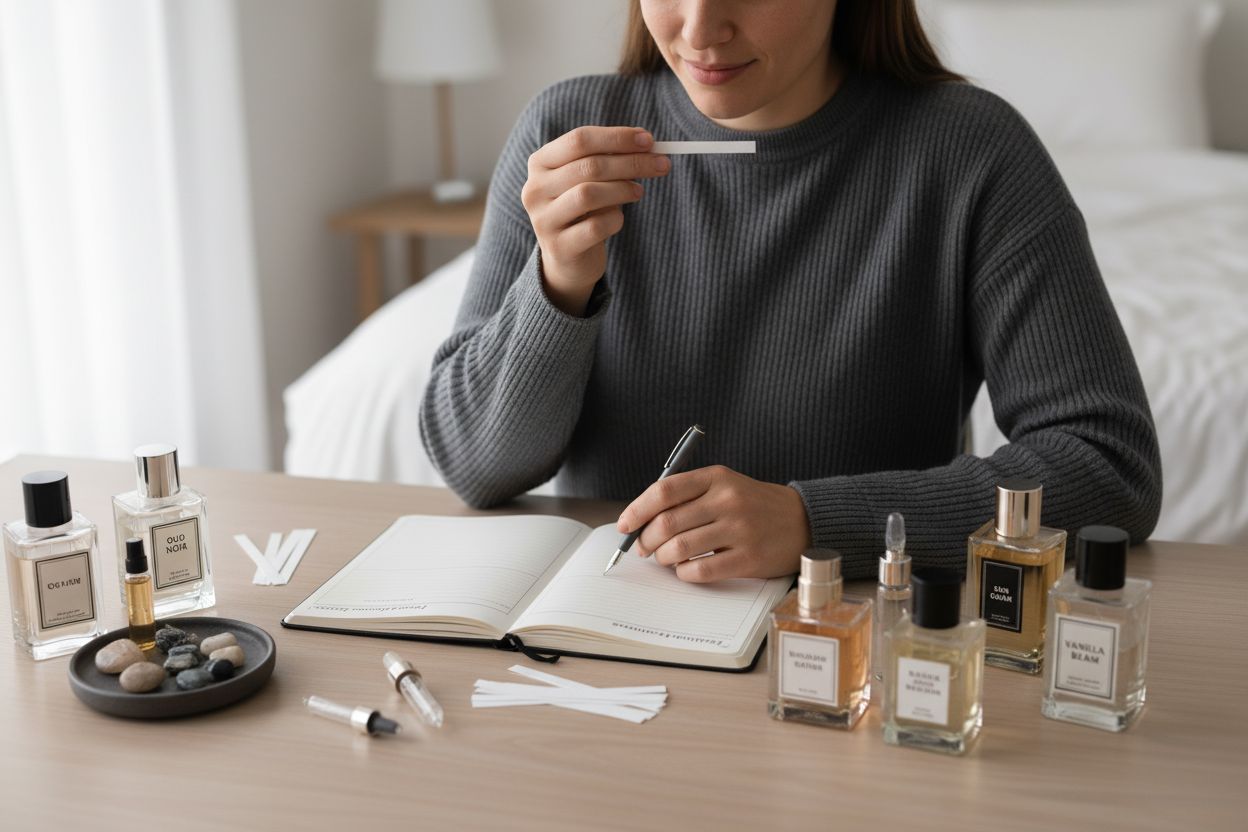Perfume is so much more than a pleasant smell on your skin. Each bottle is crafted from layers of scent known as fragrance notes, and every perfume has its own evolving identity because of this artistry. It sounds simple, but get this. A top note can evaporate in just 5 to 15 minutes, and some base notes linger for hours. Most people choose a fragrance because they like how it smells straight away. Yet, the real secret lies in understanding how those notes change and interact. This hidden symphony is what makes a scent feel truly unforgettable.
Table of Contents
- Understanding Fragrance Notes: The Basics
- Top Notes: The First Impressions in Perfumery
- Middle Notes: The Heart of Fragrance Explained
- Base Notes: The Lasting Essence of Perfume
- Examples of Floral Notes: Adding Elegance to Scents
- Examples of Fruity Notes: Fresh and Vibrant Options
- Combining Notes: Creating Unique Signature Scents
Quick Summary
| Takeaway | Explanation |
|---|---|
| Understand the three fragrance layers | Recognising top, middle, and base notes enhances perfume selection and appreciation. |
| Top notes shape initial impressions | These fleeting scents create the first reaction to a fragrance, lasting 5-15 minutes. |
| Middle notes define emotional character | Emerging after top notes, they establish the core essence of a fragrance. |
| Base notes ensure longevity and depth | The foundation of fragrances, these notes last for hours and create lasting memories. |
| Layering notes crafts unique scents | Combine different notes to create personal fragrances that reflect individual style. |
1: Understanding Fragrance Notes: The Basics
Fragrance notes form the complex aromatic language of perfumery, creating intricate sensory experiences that transform simple scents into compelling olfactory narratives. Each perfume represents a carefully orchestrated composition of top, middle, and base notes that interact and evolve over time, producing unique sensorial journeys.
These fragrance notes are essentially individual scent components that blend together, creating the overall perfume character. They are categorised into three primary layers, each playing a distinctive role in the fragrance’s development:
-
Top Notes: The initial impression, typically light and volatile, lasting 5-15 minutes
-
Heart/Middle Notes: The core of the fragrance, emerging after top notes dissipate, representing the perfume’s primary character
-
Base Notes: The foundational scents providing depth and longevity, remaining on skin for several hours
Understanding these notes allows perfume enthusiasts to appreciate the artistry behind fragrance creation. Learn more about identifying fragrance notes naturally and enhance your sensory exploration.
According to Perfumer & Flavorist Magazine, professional perfumers spend years mastering the intricate balance of these aromatic elements, treating each note like a musical instrument in a complex symphony. This meticulous approach ensures that every fragrance tells a unique story, evoking emotions and memories through carefully selected scent combinations.
Whether you prefer fresh citrus top notes, romantic floral heart notes, or warm woody base notes, understanding fragrance notes empowers you to select perfumes that truly resonate with your personal style and sensory preferences.
2: Top Notes: The First Impressions in Perfumery
Top notes represent the initial aromatic encounter in a fragrance, creating the critical first impression that determines whether a perfume captivates or disappoints. These volatile and lightweight scent molecules evaporate quickly, typically lasting between 5 to 15 minutes after application, serving as the perfume’s vibrant introduction to the wearer’s senses.
Top notes are strategically designed to entice and intrigue, functioning like an olfactory welcome mat that invites further exploration of the fragrance. Discover how to elevate your fragrance selection by understanding these crucial initial impressions.
Traditionally, top notes are characterised by bright, zesty, and refreshing scents that provide an immediate sensory impact. These typically include:
-
Citrus Families: Lemon, bergamot, mandarin, and grapefruit
-
Light Herbal Notes: Lavender, mint, and rosemary
-
Fresh Aromatic Compounds: Bergamot, neroli, and light green notes
According to The Fragrance Foundation, professional perfumers meticulously select top notes to create an instantaneous emotional connection. These initial scents trigger immediate sensory responses, potentially evoking memories, suggesting sophistication, or creating an atmosphere of freshness and vitality.
The art of crafting compelling top notes requires exceptional skill. Perfumers must balance volatility with attraction, ensuring that these ephemeral initial impressions smoothly transition into the heart notes. This delicate choreography of scent molecules determines whether a fragrance feels harmonious or disjointed, making top notes a critical component of perfume design.
3: Middle Notes: The Heart of Fragrance Explained
Middle notes, often referred to as heart notes, represent the core essence and emotional character of a fragrance. These rich, complex scent components emerge approximately 10-30 minutes after application, revealing the perfume’s true personality and establishing its fundamental aromatic narrative.
Explore our comprehensive perfume selection guide to understand how heart notes transform a simple scent into an exquisite olfactory experience.
Middle notes are strategically designed to mask the initial sharp impressions of top notes while seamlessly transitioning towards the deeper base notes. They typically comprise more mellow and rounded fragrances that create emotional resonance and depth.
Classic middle note fragrance families include:
-
Floral Notes: Rose, jasmine, ylang-ylang, and geranium
-
Spicy Accords: Cinnamon, cardamom, and nutmeg
-
Green Botanical Essences: Violet leaf, iris, and lavender
According to The Perfumer’s Workbook, professional perfumers consider middle notes the most critical layer in fragrance composition. These notes occupy the longest duration in a perfume’s development, typically lasting 2-4 hours and providing the primary emotional and sensory character.
The artistry of middle notes lies in their ability to tell a nuanced story. They must be complex enough to maintain interest yet harmonious enough to blend seamlessly with top and base notes. A masterfully crafted heart note can transform a simple fragrance into an unforgettable sensory journey, evoking memories, emotions, and personal narratives through carefully selected aromatic combinations.
4: Base Notes: The Lasting Essence of Perfume
Base notes represent the profound foundation of a fragrance, providing depth, richness, and extraordinary longevity to the entire olfactory composition. These complex molecular structures emerge approximately 30 minutes after application and can persist on the skin for several hours, creating the perfume’s most enduring memory.
Discover your signature scent within our alluring collection and explore how base notes define a fragrance’s ultimate character.
Unlike volatile top notes, base notes are heavyweight aromatic molecules that anchor the entire fragrance experience. They serve multiple critical functions beyond mere scent projection, including:
-
Fixative Properties: Stabilising and slowing the evaporation of lighter fragrance components
-
Emotional Resonance: Creating deep, complex sensory memories and associations
-
Molecular Complexity: Providing rich, sophisticated undertones that distinguish premium fragrances
According to The Society of Cosmetic Scientists, base notes typically comprise woody, musky, and resinous ingredients that interact intimately with an individual’s unique body chemistry. These profound aromatic elements include:
- Sandalwood
- Vanilla
- Patchouli
- Cedar
- Amber
- Musk
Professional perfumers consider base notes the most sophisticated layer of fragrance design. These enduring scent molecules not only provide longevity but also create a deeply personal olfactory signature that evolves uniquely with each wearer’s natural skin chemistry. The intricate interplay between base notes and individual physiology ensures that no two experiences of a fragrance are ever precisely the same.
5: Examples of Floral Notes: Adding Elegance to Scents
Floral notes represent the quintessential expression of sophistication and romance in perfumery, transforming fragrances into complex emotional landscapes that capture delicate botanical essences. These enchanting aromatic components serve as the heart of many elegant perfume compositions, offering nuanced layers of sensory experience.
Explore our collection of elegant fragrances to discover how floral notes can elevate your personal scent profile.
Floral fragrance notes are remarkably diverse, ranging from light and airy to rich and intense. They typically emerge as middle notes, providing the perfume’s core character and emotional resonance. Professional perfumers meticulously extract these botanical essences through complex distillation and processing techniques.
Key floral notes that define contemporary fragrances include:
-
Delicate Florals: Rose, jasmine, and lily of the valley
-
Intense Botanical Essences: Tuberose, gardenia, and ylang-ylang
-
Subtle Green Florals: Violet, iris, and lavender
According to The Fragrance Foundation, floral notes are scientifically complex, comprising hundreds of molecular compounds that interact uniquely with individual body chemistry. Each flower contributes distinctive characteristics:
- Rose: Romantic, soft, multifaceted
- Jasmine: Intense, sensual, slightly animalic
- Lavender: Clean, herbaceous, calming
The true artistry of floral notes lies in their ability to evoke memories, emotions, and atmospheric qualities. A masterfully constructed floral fragrance can transport the wearer to sun-drenched gardens, romantic encounters, or serene natural landscapes, making these notes far more than simple botanical representations.
6: Examples of Fruity Notes: Fresh and Vibrant Options
Fruity notes represent a dynamic and contemporary category of fragrance elements, bringing energetic, playful, and refreshing dimensions to perfume compositions. These vibrant aromatic components typically emerge as top or middle notes, offering an immediate sensory burst that captures the essence of ripe, juicy fruits.
Explore our collection of unique fragrance experiences and discover how fruity notes can transform your olfactory profile.
Fruity fragrance notes are characterized by their light, sparkling quality and ability to create instant mood elevation. They range from crisp citrus impressions to rich, complex berry and tropical fruit interpretations. Professional perfumers carefully extract and synthesize these notes to create multi-dimensional sensory experiences.
Key fruity notes that define modern fragrances include:
-
Citrus Fruits: Bergamot, mandarin, lemon
-
Tropical Fruits: Passion fruit, mango, coconut
-
Orchard Fruits: Apple, peach, cherry
According to The Perfumer’s Workbook, fruity notes interact uniquely with individual body chemistry, creating personalized scent experiences. Each fruit contributes distinctive characteristics:
- Bergamot: Bright, clean, slightly spicy
- Raspberry: Sweet, tangy, sophisticated
- Passionfruit: Exotic, vibrant, complex
The true magic of fruity notes lies in their ability to communicate freshness, youth, and spontaneity. A masterfully constructed fruity fragrance can evoke memories of sun-drenched orchards, tropical holidays, and carefree moments, transforming a simple scent into an emotional journey that transcends traditional perfumery boundaries.
7: Combining Notes: Creating Unique Signature Scents
Fragrance layering represents the sophisticated art of combining different notes to craft a truly personalised olfactory experience. This intricate process transforms individual scent components into complex, multidimensional fragrances that reflect individual personality and style.
Discover how to unveil your signature scent and learn the nuanced techniques of professional perfume composition.
Creating a unique signature scent requires understanding how different fragrance notes interact and complement each other. Professional perfumers approach this process with scientific precision and artistic creativity, balancing molecular structures and sensory perceptions.
Key principles for successful fragrance combination include:
-
Harmonious Layering: Selecting notes that naturally complement each other
-
Balanced Complexity: Ensuring no single note overwhelms the composition
-
Personal Chemistry Consideration: Understanding how individual body chemistry influences scent perception
According to The Fragrance Foundation, successful fragrance combinations typically follow strategic principles:
- Match woody base notes with fresh citrus top notes
- Blend floral heart notes with subtle spicy undertones
- Create depth by incorporating musky elements with light botanical essences
The art of combining fragrance notes is deeply personal. What works magnificently for one individual might feel entirely different on another. This unique interaction between scent, skin chemistry, and personal style makes perfumery an intimate form of self-expression. A signature scent becomes more than a fragrance—it becomes an invisible yet powerful extension of personal identity, telling a story without words.
Below is a comprehensive table summarising the key points and insights from the article to provide readers with a concise overview of fragrance notes and their significance in perfume selection.
| Key Topic | Summary | Main Examples/Benefits |
|---|---|---|
| Fragrance Note Structure | Perfume consists of top, middle (heart), and base notes that evolve over time, each with a specific role in the scent journey. | Top: Citrus, herbs; Middle: Florals, spices; Base: Woods, musks |
| Top Notes | The initial, short-lived scents encountered after application, lasting 5-15 minutes, giving the first perfume impression. | Lemon, bergamot, grapefruit, lavender |
| Middle (Heart) Notes | Form the core identity and emerge as top notes fade, lasting 2-4 hours, shaping emotional character and narrative. | Rose, jasmine, cardamom, violet leaf |
| Base Notes | Deep, rich scents that develop last, remaining for hours and providing lasting depth and fixative properties. | Sandalwood, vanilla, amber, patchouli, musk |
| Floral Notes | Offer sophistication and romance, often as heart notes, contributing elegance and nuanced complexity to compositions. | Rose (romantic), jasmine (intense), lavender (clean) |
| Fruity Notes | Present lively, refreshing and playful qualities, appearing as top or heart notes to bring vibrancy and a sense of youth. | Bergamot (zesty), raspberry (tangy), apple, passionfruit |
| Combining & Layering Notes | Blending notes crafts signature, unique fragrances tailored to personality and chemistry, for a personalised scent journey. | Citrus over woods, florals with spice, musk with botanicals |
| Benefits of Note Awareness | Understanding notes enhances appreciation, aids smarter perfume selection and enables creation of memorable, personal scents. | Informed choices, deeper enjoyment, personalised layering options |
Elevate Your Perfume Collection with Authentic Fragrance Notes
If you are ready to transform your fragrance collection, why settle for single-note scents or fleeting imitations? The article has shown how understanding fragrance notes – from zesty top notes to rich floral and woody bases – is the secret to finding perfumes that tell your own story and linger beautifully. The real frustration for many fragrance lovers is the high cost of luxury scents, the lack of depth in affordable choices, or simply not finding a bottle that truly reflects your individuality.
Experience the craft of fine fragrance with our Niche Perfumes | Verset Collection, which brings you expertly blended, European-made perfumes inspired by global designers yet offered at a price that lets you freely explore new scents.

Explore our full range on versetparfums.shop and discover why enthusiasts are choosing our Best Sellers for long-lasting, elegant alternatives. Start building a collection enhanced with vibrant citrus openings, romantic florals, and deep, memorable bases. Make your next scent choice today and bring home the luxury of true perfumery – all at a fraction of the designer price.
Frequently Asked Questions
What are fragrance notes in perfumery?
Fragrance notes are the individual scent components that blend together to create the overall character of a perfume. They are categorised into three layers: top notes, middle notes, and base notes, each contributing uniquely to the fragrance’s development over time.
How do top notes differ from base notes in a fragrance?
Top notes are the initial scents experienced immediately after application, typically lasting 5-15 minutes. They are light and volatile, while base notes emerge later and last several hours, providing depth and longevity to the fragrance.
What role do middle notes play in perfume?
Middle notes, or heart notes, form the core of a fragrance and emerge after the top notes fade. These notes typically last 2-4 hours and contribute significantly to the perfume’s primary character and emotional resonance.
Can combining different fragrance notes create a unique scent?
Yes, fragrance layering allows for combining different notes to craft personalised and complex scents. This technique involves selecting complementary notes and considering how body chemistry influences the final scent experience.
Recommended
- Master How to Identify Fragrance Notes in Perfumes – VersetParfums.Shop
- 7 Examples of Elegant Fragrances to Elevate Your Scent Game – VersetParfums.Shop
- Understanding Perfume Selection Tips for Every Buyer – VersetParfums.Shop
- Unveil Your Signature Scent: Verset Parfums’ Alluring Collection – VersetParfums.Shop









0 comments